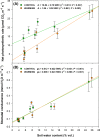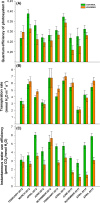Photosynthesis and growth reduction with warming are driven by nonstomatal limitations in a Mediterranean semi-arid shrub
- PMID: 27066247
- PMCID: PMC4798828
- DOI: 10.1002/ece3.2074
Photosynthesis and growth reduction with warming are driven by nonstomatal limitations in a Mediterranean semi-arid shrub
Abstract
Whereas warming enhances plant nutrient status and photosynthesis in most terrestrial ecosystems, dryland vegetation is vulnerable to the likely increases in evapotranspiration and reductions in soil moisture caused by elevated temperatures. Any warming-induced declines in plant primary production and cover in drylands would increase erosion, land degradation, and desertification. We conducted a four-year manipulative experiment in a semi-arid Mediterranean ecosystem to evaluate the impacts of a ~2°C warming on the photosynthesis, transpiration, leaf nutrient status, chlorophyll content, isotopic composition, biomass growth, and postsummer survival of the native shrub Helianthemum squamatum. We predicted that warmed plants would show reduced photosynthetic activity and growth, primarily due to the greater stomatal limitation imposed by faster and more severe soil drying under warming. On average, warming reduced net photosynthetic rates by 36% across the study period. Despite this strong response, warming did not affect stomatal conductance and transpiration. The reduction of peak photosynthetic rates with warming was more pronounced in a drought year than in years with near-average rainfall (75% and 25-40% reductions relative to controls, respectively), with no indications of photosynthetic acclimation to warming through time. Warmed plants had lower leaf N and P contents, δ (13)C, and sparser and smaller leaves than control plants. Warming reduced shoot dry mass production by 31%. However, warmed plants were able to cope with large reductions in net photosynthesis, leaf area, and shoot biomass production without changes in postsummer survival rates. Our findings highlight the key role of nonstomatal factors (biochemical and/or nutritional) in reducing net carbon assimilation rates and growth under warming, which has important implications for projections of plant carbon balance under the warmer and drier climatic scenario predicted for drylands worldwide. Projected climate warming over the coming decades could reduce net primary production by about one-third in semi-arid gypsum shrublands dominated by H. squamatum.
Keywords: Climate change; Helianthemum squamatum; dryland ecosystems; leaf trait plasticity; plant nutrient status; plant survival and growth; plant–climate interactions; stable isotopes.
Figures






Similar articles
-
Poor plant performance under simulated climate change is linked to mycorrhizal responses in a semiarid shrubland.J Ecol. 2018 May;106(3):960-976. doi: 10.1111/1365-2745.12888. Epub 2017 Oct 16. J Ecol. 2018. PMID: 30078910 Free PMC article.
-
Vertical decoupling of soil nutrients and water under climate warming reduces plant cumulative nutrient uptake, water-use efficiency and productivity.New Phytol. 2021 May;230(4):1378-1393. doi: 10.1111/nph.17258. Epub 2021 Mar 11. New Phytol. 2021. PMID: 33550582
-
Shoot biomass, δ13C, nitrogen and chlorophyll responses of two arctic dwarf shrubs to in situ shading, nutrient application and warming simulating climatic change.Oecologia. 1996 Jan;105(1):1-12. doi: 10.1007/BF00328785. Oecologia. 1996. PMID: 28307116
-
Plant carbon metabolism and climate change: elevated CO2 and temperature impacts on photosynthesis, photorespiration and respiration.New Phytol. 2019 Jan;221(1):32-49. doi: 10.1111/nph.15283. Epub 2018 Jul 8. New Phytol. 2019. PMID: 29983005 Review.
-
Drought stress and carbon assimilation in a warming climate: Reversible and irreversible impacts.J Plant Physiol. 2016 Sep 20;203:84-94. doi: 10.1016/j.jplph.2016.04.002. Epub 2016 Apr 7. J Plant Physiol. 2016. PMID: 27083537 Review.
Cited by
-
Warming Treatment Methodology Affected the Response of Plant Ecophysiological Traits to Temperature Increases: A Quantitive Meta-Analysis.Front Plant Sci. 2019 Sep 6;10:957. doi: 10.3389/fpls.2019.00957. eCollection 2019. Front Plant Sci. 2019. PMID: 31552059 Free PMC article.
-
Enhancement of ecosystem carbon uptake in a dry shrubland under moderate warming: The role of nitrogen-driven changes in plant morphology.Glob Chang Biol. 2021 Nov;27(21):5629-5642. doi: 10.1111/gcb.15823. Epub 2021 Aug 16. Glob Chang Biol. 2021. PMID: 34363286 Free PMC article.
-
Simulated climate change affects how biocrusts modulate water gains and desiccation dynamics after rainfall events.Ecohydrology. 2018 Sep;11(6):e1935. doi: 10.1002/eco.1935. Epub 2017 Dec 22. Ecohydrology. 2018. PMID: 30288205 Free PMC article.
-
Interactive Effects of Warming and Competition Do Not Limit the Adaptive Plastic Response to Drought in Populations of a Mediterranean Plant.Glob Chang Biol. 2025 Jul;31(7):e70363. doi: 10.1111/gcb.70363. Glob Chang Biol. 2025. PMID: 40709570 Free PMC article.
-
Topographic-mediated climate-NPP relationships in subtropical mountain heterogeneity units.Sci Rep. 2025 Jul 29;15(1):27541. doi: 10.1038/s41598-025-12016-4. Sci Rep. 2025. PMID: 40730622 Free PMC article.
References
-
- Allison, S. D. , and Treseder K. K.. 2008. Warming and drying suppress microbial activity and carbon cycling in boreal forest soils. Glob. Change Biol. 14:2898–2909.
-
- An, Y. , Wan S., Zhou X., Subedar A. A., Wallace L. L., and Luo Y.. 2005. Plant nitrogen concentration, use efficiency, and contents in a tallgrass prairie ecosystem under experimental warming. Glob. Change Biol. 11:1733–1744.
-
- Bai, E. , Li S., Xu W., Li W., Dai W., and Jiang P.. 2013. A meta‐analysis of experimental warming effects on terrestrial nitrogen pools and dynamics. New Phytol. 199:441–451. - PubMed
-
- Baker, N. R. , and Rosenqvist E.. 2004. Applications of chlorophyll fluorescence can improve crop production strategies: an examination of future possibilities. J. Exp. Bot. 55:1607–1621. - PubMed
-
- Barbour, M. M. 2007. Stable oxygen isotope composition of plant tissue: a review. Funct. Plant Biol. 34:83–94. - PubMed
Grants and funding
LinkOut - more resources
Full Text Sources
Other Literature Sources

